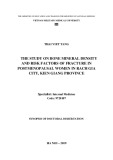
HUE JOURNAL OF MEDICINE AND PHARMACY ISSN 3030-4318; eISSN: 3030-4326 157
Hue Journal of Medicine and Pharmacy, Volume 14, No.6/2024
Factors associated with dysfunction in menopausal women in Truong
An ward, Hue city
Nguyen Thi Huong Lam1*, Le Dinh Hue2, Nguyen Thi Tan1
(1) Faculty of Traditional Medicine, Hue University of Medicine and Pharmacy
(2) Department of Physical Therapy and Rehabilitation, Hue Central Hospital, Branch 2
Abstract
Background: The study aimed to identify factors affecting dysfunction in the climacteric women.
Materials and Methods: A cross-sectional descriptive study was carried out in 410 menopausal women in
Truong An ward, Hue City. The degree of functional disorders in menopause was measured by Menopause
Rating Scale (MRS). Yin deficiency and Yang deficiency constitutions were determined by Body Constitution
Questionnaire. Results: The average scores of each sub-scale and total MRS scale were 3.05 ± 1.93, 4.70
± 2.63, 3.12 ± 1.88, and 10.88 ± 5.72, respectively. Yin deficiency constitution accounted for 69.3% and
Yang deficiency constitution 50.7%. The risk factors including: smoking with psychological (OR=9.75; 95%
CI: 2.42-39.30; p<0.05); physical activity with urogenital (OR = 3.34; 95% CI: 1.42-7.85; p<0.05); parity
with psychological (OR=1.45; 95% CI: 1.02-2.06; p<0.05); Yin deficiency constitution with psychological
(OR=1.10; 95% CI: 1.06-1.13; p<0.001), somatovegetative (OR=1.23; 95% CI: 1.18-1.28; p<0.001), urogenital
(OR=1.23; 95% CI: 1.15-1.32; p<0.001), and total scale (OR=1.31; 95% CI: 1.23-1.39; p<0.001); Yang deficiency
constitution with psychological (OR=1.11; 95% CI: 1.08–1.14; p<0.001), somatovegetative (OR=1.09; 95%
CI: 1.05–1.13; p<0.001), urogenital (OR=1.09; 95% CI: 1.03–1.15; p<0.05), and total scale (OR=1.17; 95% CI:
1.10–1.24; p<0.001). Conclusions: Smoking, physical activity, parity, Yin deficiency and Yang deficiency were
factors associated with dysfunction in menopausal women.
Key words: menopause, yin deficiency, yang deficiency, menopause rating scale, body constitution
questionnaire.
Corresponding Author: Nguyen Thi Huong Lam. Email: nthlam@huemed-univ.edu.vn
Received: 10/9/2024; Accepted: 25/11/2024; Published: 25/12/2024
DOI: 10.34071/jmp.2024.6.22
1. INTRODUCTION
Menopause is a state of permanent absence of
menstruation due to decreased ovarian function,
leading to temporary changes and disorders of some
physiological and psychological functions [1]. In
developed countries, the mean age of menopause
is between 51 and 52 years old but can also occur
between 40 and 60 years old. In Vietnam, the
average age of menopause ranges from 48 to 50
[2, 3]. Demographic data have shown that every
year approximately 25 million women worldwide
experience the climacteric and that by 2030 there
will be approximately 1.2 billion postmenopausal
women. It is estimated that about 85% of women
have at least one of the symptoms of menopause,
but only 10% of them need to seek health care
methods during this period [4].
According to Traditional Medicine (TM),
menopause is a specific period for women,
caused by Kidney-qi deficiency, the Chong and
Ren meridians being out of balance causing
menstrual bleeding to be interrupted, the body
not being able to adapt causing yin and yang to
become imbalanced. However, due to the different
characteristics of each body, the yin or yang may
be defective, so the clinical manifestations of
functional impairment during menopause are not
the same [5]. Researching the factors that impact
these disorders, including the constitution types
of yin deficiency and yang deficiency, will make an
important contribution to developing individualized
treatment plans. Therefore, the study aimed to
survey dysfunction according to Menopause Rating
Scale (MRS) and identify factors affecting these
disorders in menopausal women.
2. MATERIALS AND METHODS
2.1. Study population
The study was conducted in women aged 40
years and above, living in Truong An Ward, Hue
City. Inclusion criteria included women with natural
menopause, no return of menstruation after 1
year, and agreed to participate. Subjects who had
malignant diseases, use hormone replacement
therapy, unable to communicate and answer the
questions were excluded.
2.2. Study method
2.2.1. Study design: A cross-sectional descriptive
























